In October 1992, a train bombing by a militant group in eastern India shook the core of the massive Indian Railways. It was the first of its kind incident, at a time when bombing a public transport as a means of getting attention was at its nascent stage. The entire train network of that area shut down as the government scrambled to control damage. It caused national outrage, and a lot of frantic worry.
At home, our worries were much more small scale. This threatened our beloved, much awaited annual vacation to our grandparents. The train that had been bombed was the same one that we used to travel in to our grandparents every year. Not only that, but this blast was soon followed by another one, this time at a major railway station, Guwahati, increasing our trepidation. Normally, we would board this train from our destination station, reach Guwahati, and then change trains to board the one that would take us to our final destination. With tickets done for December, we waited in anxiety to find out if the govt would re-start the train service and whether it would even be safe enough for travel. With insurgency at its peak, we didn’t know what to expect.
Terrorism is so darned inconvenient. Being young has a lot of advantages, and extreme assurance in self’s invincibility is one of them. Our parents on the other hand, were not as confident. So we spent a lot of time convincing them how it would perfectly be fine to travel through a terror infested area.
Turns out, ours was the first train to get a green signal. Amidst tight security, checks and many nail biting hours later, our train started its journey. It was still the pre-computer era in India, which meant the massive railway network had to rely on everything manual. With a real threat of another bomb blast, every little rumor or speculation would send waves of panic amongst the brave passengers; passengers who bolted doors and pulled at the shutters of the windows at slightest of noise.
It did feel like we were on some kind of grand adventure.
The particular stretch where the blast had taken place was still under curfew. In order to get the train pass that stretch during the day time, the train was halted at a small station a day before. It was not a pre-destined stop. In India, major train stations, especially the ones that are junctions, are massive undertakings, and most of them are almost miniature cities in themselves.
However, this was a sad looking stretch of platform with not much happening. Food was scarce, and whatever little was available was bought out almost right away. A lone vendor was selling puri/bhaji – fried wheat flatbread and a pea-potato curry.
The moment he opened shop on his sorry looking cart with a mobile stove on it, a swarm of people surrounded him, buying plates that contained 4 ‘puris’ and 1 serving of pea-potato curry in multiples. The entire day the man and his young son rolled out, fried, chopped, stirred and served food. He ran out of potatoes, so got bags of them, probably from the local market and made more curry. He kneaded dough and made more puris. The best part was that it was possibly one of the best ‘puri-bhaji’ that I have ever eaten.
He probably made his fortune that day. And we reached our grandparents house without incident, travelling for about 90 hours in all.
Bringing to you that endearing recipe, simple, delicious and hearty. That peas potato curry recipe from the station.
Suggested to have it with puri, Indian fried wheat flat bread.
- 6 medium sized potatoes
- 1 cup peas (I used frozen)
- 1 tsp cumin seeds
- ½ tsp asafetida powder
- 2 Thai green chilies
- ½ tsp turmeric powder
- ½ tsp red chili powder plus 1 tsp
- 1 tsp coriander powder
- 2 glasses of water
- 1 tbsp oil (Olive)
- Salt
- Boil the potatoes, just leaving them stiff enough to be cubed.
- Season cumin seeds in oil
- When they crackle, add green chilies and asafetida
- Fry the potatoes, turning them around until they are slightly browned. They can stick to the bottom, so make sure you scrape them off while stirring.
- Add turmeric, salt and ½ tsp red chili powder.
- Put in the frozen peas and turn the flame high till the peas soften and start cooking, then turn the heat to medium.
- Add 1 glass of water. Bring to a boil on high. Now put it on simmer for 45 minutes. Keep stirring every 15 minutes, and then add water as it thickens. The curry will be thick and a bit mushy.
- Now, add coriander powder, and red chili powder and 1 cup of warm water.
- Check for salt, and cook for another five minutes.
- Serve with Luchi/puri.

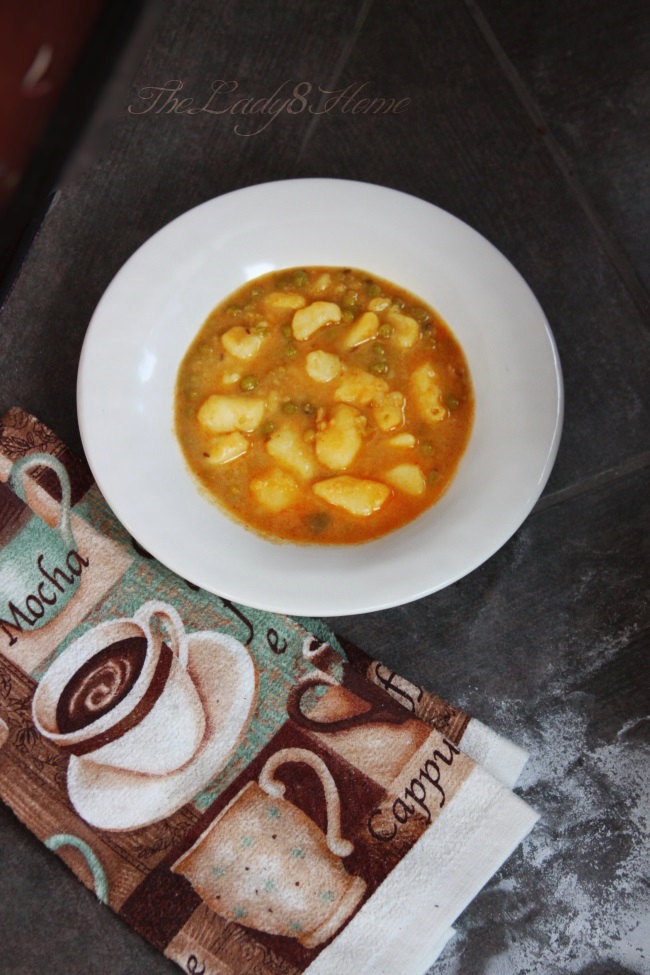
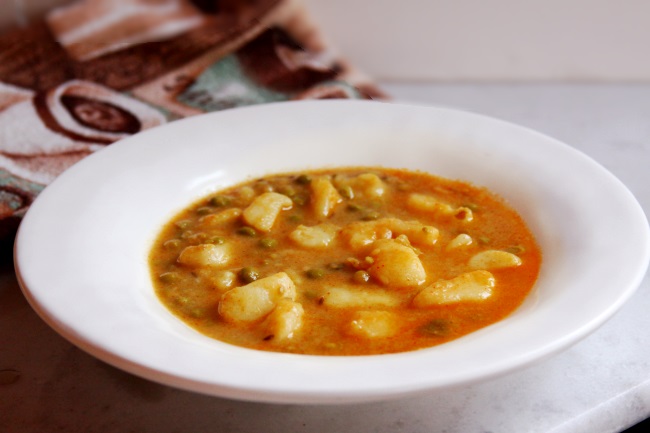
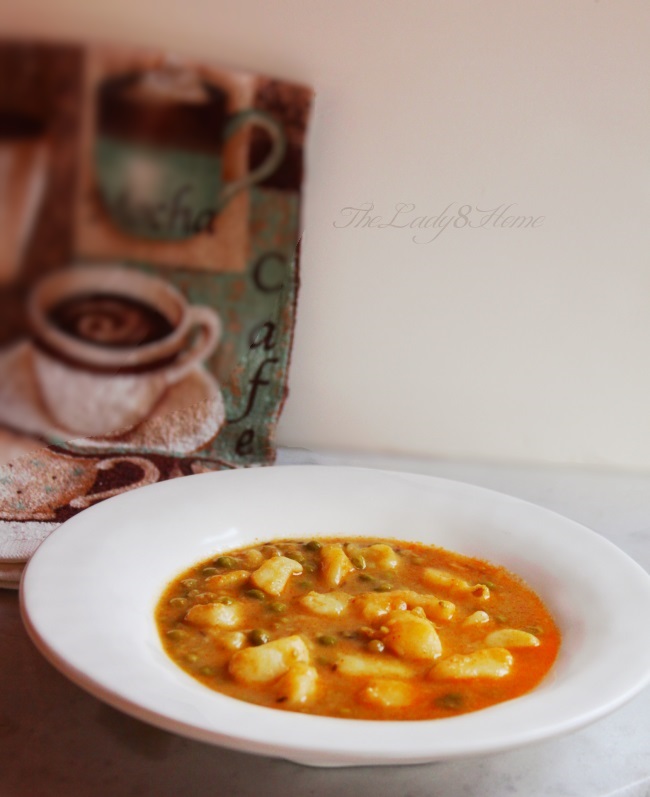
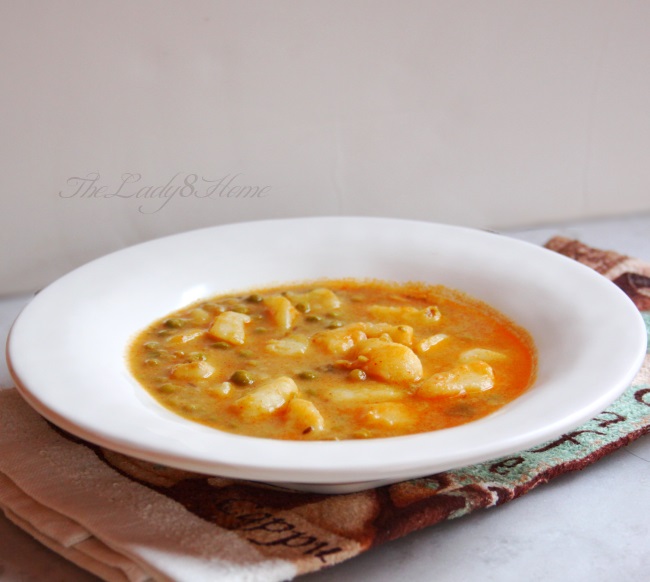
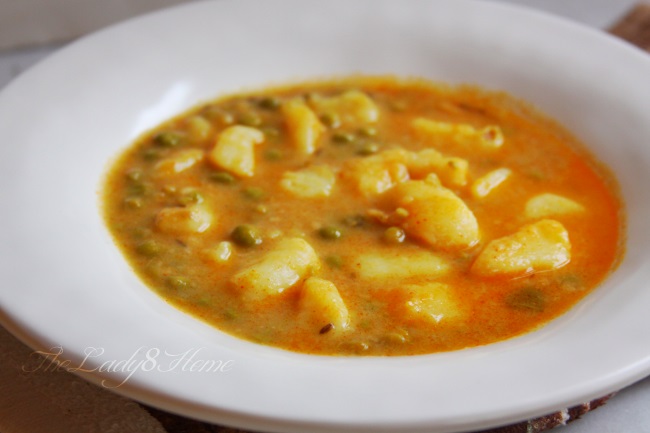

17 comments for “Bhaji puri station wala: a peas and potato curry, a popular street food”